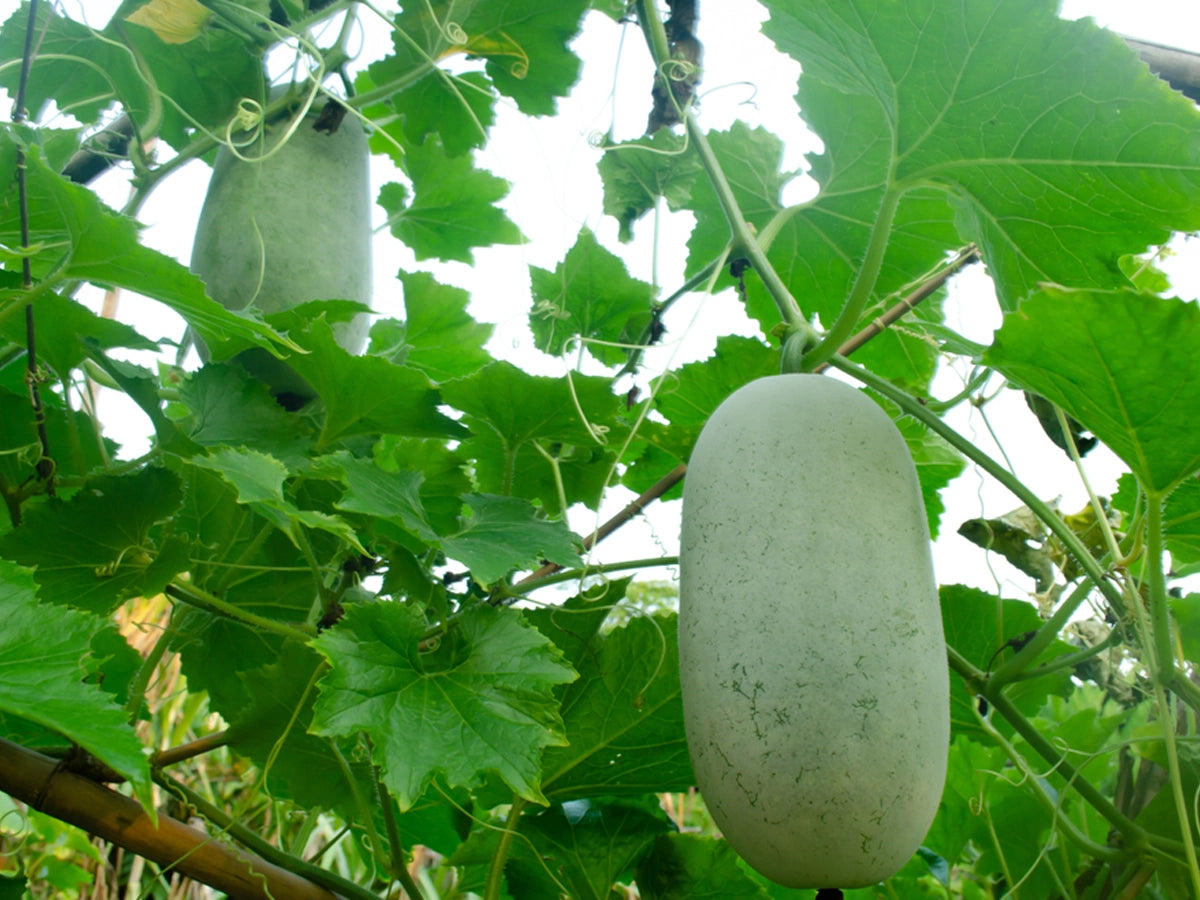How to Grow
Petha (Winter Melon): Facts, Benefits, How to Grow & Care Tips
Are you in search of a new and exciting vegetable to add to your meals? Or are you looking to add some excitement and variety to your culinary repertoire?
Petha, a unique and delicious vegetable, native to South and Southeast Asia, is a popular vegetable in Asia, particularly Java and Japan, where it is believed to have originated. This gourd, which is often pickled or candied, has a sweet and slightly sour taste that is sure to delight your taste buds.
Not only is Petha a tasty treat, it also has several health benefits. It's a healthy snack loaded with vitamins and nutrients, and it is believed to have digestive and detoxifying properties. Plus, it's a low-calorie snack that can be enjoyed guilt-free.
So why not give it a try?
In this blog, we will be discussing:
- Facts about Petha
- Benefits & Uses of Petha vegetable
- How to grow Petha at home
- How to take care of Petha plants
Some exciting facts about Petha
- Petha is a type of gourd, also known as white pumpkin or ash gourd, that is native to the Asian continent.
- It is often candied or pickled, giving it a sweet and slightly sour flavor that is loved throughout northern India.
- Petha vegetable is also available in a variety of savory flavors, including spicy chili and tangy lemon, and can be cooked in savory dishes.
- The candied version of Petha is known as "Petha halwa" and is a popular dessert in India.
- Petha is packed with vitamins and minerals and is believed to have digestive and detoxifying properties, making it a healthy snack option.
Benefits & Uses of Petha Vegetable
Petha is not only a tasty treat but also has a number of potential health benefits. Here are a few reasons why you should consider adding Petha to your diet:
Digestive benefits
Petha is rich in dietary fibers, which can help with digestion and may help to prevent constipation. Petha is also a good source of iron, which can help to prevent anemia and improve your energy levels. Petha can be used as a natural treatment for many common gastrointestinal problems. It may also help to reduce flatulence and bloating and eliminate toxins from the body.
Detoxifying properties
Petha is believed to have detoxifying properties and may help to remove toxins from the body.
Boosts the immune system
Petha is rich in antioxidants and has anti-inflammatory properties, which may help to boost the immune system. It may also help to strengthen the body’s defenses against infections.
Low in calories
Petha vegetable is a low-calorie snack, making it a guilt-free treat. It contains fewer than 100 calories per serving. Petha is a good source of dietary fiber, which can help to keep you feeling full for longer and prevent overeating.
Contains essential nutrients
Petha is rich in several essential nutrients, including vitamin C, calcium, iron and magnesium. It may also provide some B-complex vitamins such as folate and thiamine.
Hydration
Petha is believed to have cooling properties and is often consumed during hot summer months in India to help with hydration. Petha can help to reduce body heat by increasing saliva production and improving the flow of blood in your circulatory system.
Cooking
Petha is often consumed as a snack. It is a popular treat in northern India and can be found in a variety of flavors, including mango, pineapple, and orange. "Petha halwa" is also a popular dessert made by cooking Petha with milk and sugar until it becomes a thick, sweet paste.
Petha can also be used as an ingredient in savory dishes, such as curries and koftas. It has a soft and spongy texture and adds a unique flavor to the dishes.
Medicine
Petha is believed to have a variety of health benefits in Ayurvedic medicine, including improving strength and intellect and acting as a tonic.
It is said to have nutritive, alterative, laxative, diuretic, aphrodisiac, styptic, cooling, and anti-mercurial properties. The juice of the fruit is used to treat bleeding disorders, and is used to treat various ailments such as asthma, insanity, epilepsy, burning sensation, diabetes, piles, dyspepsia, fever, and conditions related to an imbalance of pitta.
The fruit is also thought to be an effective remedy for poisoning by vegetables, mercury, and alcohol.
The seeds of the Petha are said to have cooling, anthelmintic, brain-tonic, cardiac tonic, and antipyretic properties and are used to treat dry cough, fever, abnormal discharge from the urethra, syphilis, excessive thirst, and conditions related to an imbalance of pitta. They are also used to expel tapeworms and bladder stones.
These are just a few of the many uses for Petha. With its unique flavor and versatility, it is a valuable addition to any kitchen.
How can you easily grow Petha at home?
Petha plants are generally grown in the warm season. In India, Petha is typically grown in the summer months, from April to June. However, Petha can also be grown in other tropical and subtropical regions with long growing seasons.
Petha can be grown at home in a number of ways. Here is the step-by-step process for easily growing Petha at home:
- Choose a sunny location to plant your Petha seeds. Petha plants prefer full sun and well-draining soil, so choose a sunny spot in your garden, balcony, or terrace to grow it. The ideal pH range for Petha plants is between 6.0 and 7.0. You can also test the pH of the soil using a testing kit for soil.
- Prepare the soil by loosening it and adding compost or well-rotted manure to improve its fertility. Adjust the pH of the soil if necessary by adding sulfur to lower the pH or lime to raise the pH.
- Sow the Petha seeds directly in the soil, spacing them about 2-3 inches apart. Cover them lightly with soil and remember to water them well.
- Keep the soil moist but not waterlogged. Water the plants regularly, especially during dry periods.
- As the plants grow, thin out any overcrowded seedlings to leave space for the remaining plants to grow.
- To prevent Petha plants from falling over, it is important to provide them with support. This can be done through the use of trellises or stakes. Petha plants can grow quite large, so it is essential to ensure they have proper support to keep them upright.
- Petha fruits are ready to harvest when they are firm and have reached their full size. Use pruning shears or a sharp knife to cut the fruits from the plant, being careful not to damage the vines.
With proper care, you can easily grow Petha at home and enjoy this tasty and nutritious vegetable in your meals.
How to take good care of Petha plants?
Taking good care of your Petha plants is essential for a healthy and bountiful harvest. You can take good care of your Petha plants by following the steps below:
Water
Water your Petha plants regularly, but be sure not to overdo it. Soil that is too wet can lead to root rot and other problems. Water your plants in the morning to give the foliage time to dry off before nightfall, which can help prevent diseases.
Sunlight
Petha plants love the sun, so make sure to choose a sunny location for your plants. Full sun exposure is best for Petha plants. Ash gourd plants require at least 6 hours of direct sunlight per day to grow and produce fruit.
Soil
Petha plants prefer well-draining soil and a pH range of 6.0 to 7.0. Test your soil's pH regularly to ensure it is within the ideal range for Petha plants.
Location
If you are planning to grow Petha vegetables in your home or garden, it is important to choose a location that gets plenty of sunlight, you can choose between your terrace, balcony, home garden or backyard!
If you are growing ash gourds in containers on your terrace or balcony, it is important to choose containers that are large enough to allow for proper growth. Ash gourd plants can grow to be quite large, so make sure to use containers that are at least 18 inches in diameter and have drainage holes to allow excess water to drain out.
Temperature
Petha plants prefer warm temperatures, between 15-24°C (60-75°F). If you live in a cooler climate, be sure to protect your Petha plants from frost.
Fertilizer
Petha plants benefit from regular fertilization. Apply a balanced fertilizer with equal amounts of nitrogen, phosphorus, and potassium (NPK) every 2-4 weeks. These nutrients are essential for plant growth and can be obtained through fertilizers or added to the soil through composting.
It is always a good idea to follow the recommended guidelines on the fertilizer package and to test the soil to determine its nutrient levels before applying any fertilizers.
Pruning
Petha plants do not typically require pruning. However, you may need to thin out overcrowded seedlings as the plants grow.
Pests and diseases
Petha plants can be affected by pests and diseases, such as aphids and powdery mildew. Keep an eye out for any signs of infestation and take appropriate action, such as using organic pest control methods or removing infected plants.
Conclusion
We hope you found all the relevant information you were looking for here. Petha vegetables are an excellent choice for adding a new taste to your meals, or for cooking up a tasty, healthy snack for your family.
There are many uses for this versatile vegetable, and what's more, it can be eaten raw, pickled, or dried. You'll find that it pairs nicely with a variety of other foods, so give it a try at your next meal.
FAQs Related to How to Grow Petha
What is Petha vegetable and where does it come from?
Petha is a type of gourd native to South and Southeast Asia and is widely consumed throughout the region, including in Java and Japan. It is also known as white pumpkin or ash gourd and is particularly popular in northern India.
What are the health benefits of Petha vegetables?
Petha is believed to have several potential health benefits. It may aid in digestion and help to detoxify the body, and it is also believed to have immune-boosting properties.
Can Petha vegetables be grown at home?
Yes, you can grow petha vegetables at home easily. All you need is well-draining soil and a sunny spot to start with. This low-maintenance plant will require minimal maintenance.
How is Petha vegetable typically used?
In addition to being enjoyed as a snack, Petha vegetable can also be used as an ingredient in dishes like halwa, kofta, and curries. Traditional Ayurvedic medicine often incorporates petha to treat various ailments.
Is Petha vegetable only available in India?
Petha vegetable is primarily grown and consumed in India, but it can also be found internationally at some grocery stores or online. Petha is a crop that grows well in humid and heavy rainfall regions. So, if you belong to such a climate, you can grow it at home easily.
References
https://www.lybrate.com/topic/winter-melon-Petha-benefits-and-side-effects
https://pharmeasy.in/blog/foods-good-for-anemia/
https://www.healthifyme.com/blog/ash-gourd/
https://www.slurrp.com/recipes-list/7-exciting-Petha-recipes-to-sweeten-your-days-1634128285704





